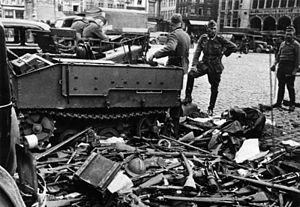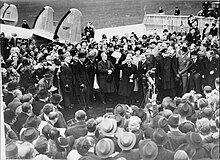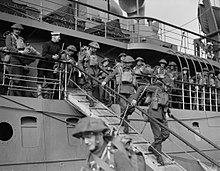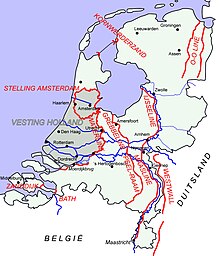Attack on the Netherlands, Belgium and Luxembourg
| date | May 10-28, 1940 |
|---|---|
| place | Belgium |
| output | German victory |
| Parties to the conflict | |
|---|---|
| Commander | |
|
|
|
| Troop strength | |
|
|
|
The attack on the Netherlands , Belgium and Luxembourg in World War II began on May 10, 1940 and, as “Fall Gelb” in the context of the German campaign in the west, represented an essential aspect of the attack plan against France (“ Fall Rot ”). The German invasion ended after 18 days on May 28, 1940 with the capitulation of the Belgian armed forces and the occupation of the three countries by Germany .
Just as no consideration was given to national borders in the course of the German plan of attack, the defense is partly a matter of joint military operations and defense concepts of the countries concerned.
Political and military situation in Europe in early 1940
In 1920 Belgium had concluded a military agreement with France , according to which the Belgian army had to support the French troops in the event of a German attack on France, and which in any case provided for joint military action. On March 7, 1936, German troops occupied the demilitarized zone of the Rhineland . Since there was no French reaction to this occupation, Belgium now questioned the credibility of France and stipulates strict neutrality as a new security guideline .
When Czechoslovakia was broken up in 1939 , the French ambassador Robert Coulondre in Berlin only presented a protest note. The break-up of Czechoslovakia was seen as an open breach of the Munich Agreement and resulted in a worsening of the international situation. The United Kingdom , France, Poland , the United States of America and the Soviet Union did not recognize the de facto annexation of Czechoslovakia. Great Britain deviated from its previous appeasement policy and on March 31, together with France, issued a British-French guarantee to the Polish state .
On August 23, 1939, the German-Soviet non-aggression pact was signed. At that time, the Belgian government assumed that it was viewed by Germany as an ally in the war against the east and west. Belgium mobilized the army three days later and the Netherlands on August 28th. At the beginning of the German attack on Poland on September 1, 1939, the Belgian high command initially saw little danger from the German side. All attention was paid to the Franco-British alliance, fearing that it would extend to Belgian territory. The subsequent declaration of war by France against Germany initially only led to a mobilization of the reserves and a limited and unsuccessful offensive on the Saar. With the simultaneous British declaration of war on Germany on September 3, 1939, the so-called " seat war " began, which lasted until the German attack on France .
After the fall of the Polish capital on September 28, 1939, Belgium decided to move the majority of its troops to the Eastern Front on the assumption that Germany, for its part, wanted to move parts of its army to the west. This turned out to be the right decision in autumn 1939 when Adolf Hitler ordered the attack in the west.
The aim of the German invasion
With the outbreak of war on Germany's western front, the foundation stone was to be laid for the German invasion of the United Kingdom, in order to ultimately achieve superiority on the European continent. The original target was to wipe out strong Belgian-British-French forces and destroy ports on the North Sea coast in order to take possession of them later. Due to the immediate success, the original objective of the operation under General Field Marshal Erich von Manstein was expanded to an overall victory on the Western European continent.
The goal of the Netherlands, Belgium, Great Britain and France, however, was to avert the German threat. Until the day of the invasion on May 10, 1940, the Belgian government adhered to its policy of neutrality and did not allow foreign troops on Belgian territory. French troops and the British Expeditionary Force (BEF) were only stationed in France, near the Belgian border.
Mobilization and derogations
Belgian army
The Belgian army , which consisted of 100,000 men in peacetime, was increased to 22 divisions as part of the mobilization from late August 1939 to early May 1940 . At the beginning of the fighting, the field army consisted of four regular army corps and three reserve corps, each with two to three divisions and a ( partially motorized) cavalry corps, a coastal group, an independent operations group and two independent infantry divisions. The total strength of the mobilization was around 550,000 soldiers, a remarkable achievement for a small country with eight million inhabitants. The Belgian army mainly consisted of professional soldiers , conscripts and reservists .
The troops were quartered in public buildings, schools and wooden barracks near the prepared defensive positions. The daily routine consisted of military instruction, target exercises, organization in the defense positions and field work. Emergency exercises were also held. After an emergency landing of a German Messerschmitt Bf 108 in the night hours of January 10, 1940 ( Mechelen incident ), the alarm was triggered for the first time. The actual alarm was issued on April 9, 1940, after the German invasion of Denmark and Norway ( Weser Exercise Company ).
In the course of the mobilization, exemptions were also issued. Larger family fathers, teachers, railroad workers, miners and mining engineers were released from the army and sent home. In addition, farmers were given leave of absence. There were a large number of reserve officers among this group of people . Many soldiers felt these exceptions were unfair. Discipline and morals were affected and were further undermined by Nazi propaganda and nationalist-minded Belgians ( Rexists ).
French army
In France the mobilization took place in the same way. In May 1940, the French army on the north-east front, which stretched from Switzerland to the North Sea, was divided into 1st, 2nd and 3rd Army Groups and the 7th Army. Colonial troops from Algeria, Morocco and Tunisia were also considered part of the French national armed forces, and North Africans made up a large proportion of the French army. There were nine divisions of colonial infantry, and the 102nd Fortress Division in the Maginot Line each had a half-brigade of machine-gunmen from Indochina and Madagascar. In addition, a number of French divisions were brought to full strength by the addition of regiments from the colonies.
Exceptions were also made in France. These exceptions were felt there as “ special allure ” and had the same moral effects on the army as those in Belgium. The French high command saw no threat or imminent danger to France at this point. Even after the German invasion of Poland was over, peace was hoped for soon.
British Army
There was little fighting on the Western Front in the first six months of World War II , with the exception of a small and half-hearted French offensive in the Saar region. The British Expeditionary Force BEF carried out exercises, strengthened its positions and set up depots and storage facilities. From November 1939 on, in consultation with the French, one of the English divisions was always on the Saar front for a short period of time and under French command in order to gain operational experience. At the end of April 1940 the BEF had a strength of 394,165 men and was divided into ten divisions.
Dutch army
Since the Dutch government hoped to be able to remain outside the war , as in the First World War , in the Second World War, it was not prepared to plan a joint defense with the Belgians or the Allies. The Dutch army, consisting of nine divisions, as well as 125 mostly older aircraft, were not able to cope with the modern armed forces . As the fighting continued, the Dutch army did not retreat south towards the approaching Allied troops, but rather into fortress Holland .
Luxembourg Force Armée
The Luxembourg government hoped that the signatory states to the London Treaty would respect the country's neutrality. The Grand Duchy had only one armed force made up of the Gendarmerie Grand-Ducale and the volunteer company . When the war broke out, the nominal strength of these two units was only 260 gendarmes and 300 professional soldiers. The government began building a line of defense along the borders in February 1940. The system, called the Schuster Line, consisted of 41 concrete barriers and iron gates, which, however, did not significantly slow down the German advance during the invasion on May 10, 1940. The government and the population hoped for military intervention by the French army in the event of a defense.
Belgian and Dutch defense plan
Belgian plan with French and British support
Despite a policy of neutrality, the Belgian and French military leaderships worked with the British to develop a joint defense plan in strict secrecy. A kind of new edition of the Schlieffen Plan from 1914, including the Maginot Line, was used as a solution to prevent a German advance in the lowlands. In fact, the Germans' initial plans included a campaign in the west, with a focus on the wave of attacks on northern Belgium.
This common strategy was based on a " defensive, linear resistance ". Essentially, it was the model of the war on the front lines as in the First World War. The Belgians had three fortified places with Liège, Antwerp and Namur; the bulk of the army (20 divisions) was to be deployed in the border positions with Germany, Luxembourg and the Netherlands as well as in the depths of the Albert Canal . The expansion of a third line of defense, the KW position (Koningshooikt-Wavre position), referred to by the Allies as the Dyle-Breda position, did not begin until August 1939.
The French planned not to undertake any cross-border operations until early summer 1941. German attacks were to be repulsed on the Maginot Line stretching from the border with Switzerland to Sedan, in which Army Groups 2 (Prételat) and 3 (Besson) were deployed. The aim was to stop an attack over Belgium in the Dyle Breda position. Army Group 1 (Billotte) was to be deployed in it together with the British Expeditionary Corps (9 divisions) and parts of the Belgian and Dutch armies.
The Dutch Defense Plan
In the Netherlands, however, as in the First World War, people hoped to be able to maintain their neutrality status and were therefore not prepared to make joint defense arrangements, which is why separate defensive lines were planned along the Meuse and IJssel. The Peel-Raam and Grebbe positions were planned as a further line. The " Fortress Holland " (Amsterdam, Rotterdam, The Hague) was to be defended on the " New Dutch Water Line " at Utrecht level. The development status of these lines could not be compared with that of the Belgians and could be classified as poor. Likewise, the level of training of the Dutch troops could not keep up with that of the Belgians.
Common operational strategy and tactics
The "Dyle-Breda Maneuver" was developed as an operational strategy, which included the following operations by the resistance countries:
The motorized French 7th Army moved to the area north of Antwerp to Breda and took up positions there to ensure the connection to the Dutch troops. The task of the Belgian troops was to keep the fortresses in the defense of Antwerp and to occupy the prepared KW position around Leuven. The British expeditionary corps then occupied the open points between Leuven and Wavre.
The French 1st Army occupied the prepared defensive positions between Wavre and Namur. The French 9th Army and the French 2nd Army took up the defensive positions on the Meuse south of Namur. In this way, the defensive positions stretching from the Netherlands to the Swiss border were continuously occupied by Dutch, Belgian, French and British troops. A confrontation with German troops was expected as in the First World War.
The use of the Belgian army
Political, military and tactical consideration
For political, military and tactical reasons, three advanced positions (a cover position, an advanced position and an alarm position), which were occupied by the Belgian army, were determined by the Belgian high command in front of the actual resistance line (KW position). Due to considerable political pressure, a further deployment in the hinterland was not carried out, as public opinion could not be convinced to give priority to the deployment of the Belgian army on the Antwerp-Namur line on the French border. In order to justify the three advanced positions, internal political views had to be taken into account, which had considerable effects on public opinion, primarily due to the neutrality policy and a possible French invasion.
The KW position (Koningshooikt Wavre position)
This main position consisted of a continuous line of anti-tank barriers ( Belgian gates , railway fields, anti-tank trenches ) and was additionally reinforced by combat and communication bunkers. The position was supplemented by trenches and barbed wire fences and expanded with anti-tank cannons and machine guns. However, the KW position was not occupied from the outset.
On May 10, 1940, only the 10th Infantry Division was stationed at the KW position. More than half of the Belgian army was deployed on the three advanced lines at this time. It was only a few days later that the Belgian 2nd Army Corps (6th, 9th and 11th Infantry Division) and the 6th Army Corps (2nd, 5th and 10th Infantry Division) defended the KW position in the Belgian sector.
The alarm position
The alarm went along the border with the Netherlands (Dutch Limburg) and on the border with Germany. This alarm line was used to recognize every border crossing immediately and to be able to report it immediately. This position was occupied by territorial brigades of the Belgian gendarmerie and assigned Belgian army units. In the event of a necessary withdrawal from strategic points (e.g. bridges), the troops had to retreat to the advanced position.
The advanced position
The advanced position ran along the border from Antwerp to Arlon via Maaseik . This additional position served to test the strength of the German troops and to offer temporary resistance in order to be able to occupy the cover position along the Albert Canal for the most part without enemy influence by other units. This advanced position has been divided into two more separate areas. Sector north ran from Antwerp to Lanaken. Sector south ran from Welkenraedt (Hendriks Chapel) to Arlon. Between Lanaken and Liège the advanced position ran along the Albert Canal, while the fortresses in the vicinity of Liège lay between the two sectors.
In the northern part, the advanced position ran from the Dessel-Turnhout-Schoten canal, across the Maas-Scheldt Canal and the Belgian part of the Zuid-Willemsvaart . To strengthen this area, several machine gun bunkers were built along the canal. In most cases, these bunkers were equipped with two firing lobes for two machine guns each. This allowed the defenders to cover the entire length of the canal in the event of an enemy attack. No further expansion was carried out in the southern sector, as this sector was already fortified by individual, branched bunkers.
On May 10, 1940, all defensive positions and bunkers of the advanced position were occupied. The Belgian army command consistently positioned mobile units (bicycle, motorcycle or truck) along the positions. These mobile reconnaissance units of the infantry divisions and cavalry corps could quickly be moved from the positions they were now assigned to cover if necessary.
- In Turnhout itself, units near Antwerp occupied the positions
- The mobile reconnaissance unit of the 15th Infantry Division was set up between Turnhout and Arendonk . It was about 3 squadrons of cycling troops with less heavy weapons but a larger reconnaissance radius.
- The mobile reconnaissance unit (bicycle troops) of the 18th Infantry Division occupied the defensive position between Arendonk and Lommel .
- The most important part of the position, between Lommel and Lanaken , was occupied by considerably better equipped units. For this purpose, a temporary combat force "Ninitte" was set up. This was under the command of the cavalry corps. It consisted of the 1st Gendarmerie-Radfahrregiment, which occupied the section between Lommel and Kaulille, the 2nd motorized truck regiment, between Kaulille and Eisden and the 1st Jäger-Regiment on horseback between Eisden and Lanaken. In addition, this combat force was reinforced by mobile units from the 17th Infantry Division between Briegden and Vucht and the 5th and 6th Company.
On the same day, these positions were attacked in several places between Maaseik and Briegden by German troops who had crossed the Maas.
The cover position
The cover position ran along the Albert Canal and included the forts around Liège and the Meuse around Namur. Machine gun bunkers were built in front of the waterline every 600 meters along the canal. All bridges were mined with explosive charges, fields were flooded and anti-tank barriers were built. The cover position was occupied by 14 Belgian divisions, more than half of the Belgian army.
The German attack (case "yellow")
Since the end of 1939, troops that had previously been deployed in Poland were moved to the Benelux border in "rest position" and practiced an attack that was not carried out until the spring of 1940 because the raid on Denmark and Norway had been brought forward . In the morning hours of May 10, 1940, the first phase of the campaign in the west, the attack on the Netherlands, Belgium, Luxembourg and northern France, took place. The Army Group B , with the support of Airborne Corps attacked in addition to parts of the border fortifications of the Belgians Albert channel especially bridges and airfields in the hinterland and occupied them.
The targets were taken possession of almost everywhere, the bridges over the Hollandsch Diep near Moerdijk, the Noord near Dordrecht and the New Maas near Rotterdam fell intact into the possession of the German army. The Waal Bridge Nijmegen and the bridge near Arnhem could be blown up before the German invasion. Further strategically important bridges in Belgium and the Netherlands could be secured through command operations of small troops immediately before the start of the offensive until the arrival of German ground troops.
The Allies - Belgium
The Wehrmacht's rapid advance had taken the Allies by surprise. The French army had collapsed and the British expeditionary force was retreating to Dunkirk. The Belgian troops tried their best to cover this retreat. The Dyle Breda position was breached on May 16, and one day later Brussels was occupied by German army units without a fight. The Belgian army was encircled in the Bruges area and ceased fire on May 28 at 4:00 a.m. King Leopold III. signed the surrender of the Belgian army and went into captivity with his soldiers.
The Allies - France
The German Army Group A crossed the Meuse under General Heinz Guderian with the intention of advancing deep to the northwest from a safe crossing of the Meuse towards the coast of the English Channel and thus into the rear of the Allied troops advanced to Belgium according to the Dyle Plan. On May 13, 1940, with the Battle of Sedan, the most important part of the German plan to encircle the Allied armies in Belgium and northeastern France (" sickle cut plan ") began.
On May 15, the Germans defeated the last French defenses and penetrated westward into the strategic depths of the Allied front. Five days later, on May 20th, German tanks reached the English Channel at Abbeville . The Battle of Sedan contributed significantly to the rapid defeat of France.
The Allies - Great Britain
On May 10, 1940, the British Expeditionary Force (BEF) occupied the planned positions in Belgium. After the German breakthrough at Sedan, the British withdrew from Belgium. The German advance made unexpectedly rapid progress, so that the British War Cabinet was already considering evacuating the BEF on May 19.
As part of Operation Dynamo , almost the entire British expeditionary force in France and parts of the French army, which were surrounded by German troops near Dunkirk, were evacuated to Great Britain by sea from May 26 to June 4, 1940.
The Allies - Netherlands
On May 13, 1940, heavy fighting took place over Rotterdam, one of the cornerstones of "Fortress Holland". On May 14th, an attempt to persuade the Dutch city commander, Colonel Pieter Scharroo , to surrender the city failed , which is why the defenders of Rotterdam were threatened with an imminent bomb attack. Despite a successful, extended, mutual ceasefire, only the second squadron of the approaching Kampfgeschwader 54 could be ordered back by a counter order due to communication difficulties. For example, 57 bombers of the first squadron on the approach to Rotterdam dropped a total of 97 tons of explosive bombs, assuming that their order to attack was still in place. The old town was destroyed, but the defenses were hardly hit.
1,728 civilians were killed in the air raid on Rotterdam . This event, along with the threat of another attack on Utrecht, which was also tenaciously defended, and the almost hopeless overall military situation, is seen as decisive for the decision to surrender the Dutch armed forces in the motherland as a whole. It was broadcast on May 14 at 8:30 p.m.
consequences
Netherlands
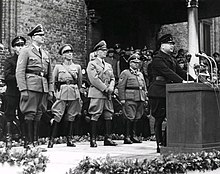
On May 18, 1940 Arthur Seyß-Inquart was appointed Reich Commissioner for the Netherlands . General Friedrich Christiansen became the Wehrmacht commander in chief for the Netherlands . Under German rule, compulsory labor and the persecution of Jews began. With the help of the Dutch National Socialist Movement (NSB) under Anton Mussert an attempt was made to nazify the so-called related Germanic people. After the war, the Netherlands should be integrated into a Greater Germanic Empire.
Queen Wilhelmina and the government fled to London and formed a government in exile there . The Dutch navy and parts of the air force escaped German access and continued to fight on the side of the Allies. Dutch East Indies with the Royal Dutch Indian Army submitted to the government in exile and later fought as part of the ABDACOM on the side of the Americans, Australians and British against the attacking Japanese in Southeast Asia.
Luxembourg
The German Foreign Minister Joachim von Ribbentrop assured on May 10, 1940 that the territorial and political independence of the Grand Duchy of Luxembourg would not be affected. But Luxembourg was actually placed under military administration on August 2nd. Then it was as CDZ-area Luxembourg under Gustav Simon on Hitler's orders Germanized and international law annexed. Simon initiated the persecution of the Jews, introduced the Reich Labor Service for young Luxembourgers and 10,211 Luxembourgers were forced to do military service in the armed forces or the SS, which was contrary to international law.
Belgium
Annexation of East Belgium
Before the surrender of the Belgian army on May 28, Ostbelgien , d. H. the areas of Eupen , Malmedy and Moresnet annexed in violation of international law and incorporated into the NSDAP district Cologne-Aachen. The German-speaking population welcomed the move, but was also forcibly recruited by the German Reich from 1941 to serve in the armed forces or the SS . After the Allies liberated Belgium, the Belgian collaboration laws were applied to them as well.
Government in exile
The Hubert Pierlot government fled into exile via Limoges to London and was able to continue the fight with the free Belgian armed forces ( Forces belges libres ). The Belgian Force Publique ( Congolese colonial army) fought in North Africa and the East Africa campaign, and in England, in addition to the Piron Brigade , air force units were also formed. King Leopold III stayed in Belgium and was held in the forced residence at Schloss Laken .
Belgium and Northern France
With the military commander Alexander von Falkenhausen and the head of administration Eggert Reeder , the military administration was set up in Belgium and northern France , which pursued a nationality and Flemish policy and worked with the Flemish national association , the Rexists and the civil administration found there. Under German rule, compulsory labor and the persecution of Jews were introduced. On June 12, 1944, six days after D-Day , the German military administration in Belgium and northern France was converted into the civil administration of the short-lived Reichskommissariat Belgium and Northern France , whose head from July 18, 1944 was Josef Grohé .
Legal processing
Crimes against peace
The planning and implementation of the unprovoked war of aggression against the neutral states of Holland, Belgium and Luxembourg were accused of leadership crimes in the Nuremberg trial against the main war criminals of the military and political leadership and condemned as such.
literature
- Karl-Heinz Frieser : Blitzkrieg legend. The western campaign in 1940 (= operations of the Second World War. Volume 2). 3. Edition. Oldenbourg, Munich 2005, ISBN 3-486-56124-3 .
- Erich von Manstein : lost victories. Memories 1939–1944. Bernard & Graefe Verlag, Koblenz 1987, ISBN 3-7637-5253-6 .
- Heinz Guderian : memories of a soldier. Motorbuch Verlag, Stuttgart 1986, ISBN 3-87943-693-2 .
- Helmut Lensing, The Emsland / Grafschaft Bentheim region and the German attack on the Netherlands in the spring of 1940 in the mirror of sources, in: Study Society for Emsländische Regionalgeschichte (Ed.), Emsländische Geschichte, Vol. 21, Haselünne 2014, pp. 317-563 .
- Klaus A. Maier, Horst Rohde, Bernd Stegemann, Hans Umbreit: The German Reich and the Second World War . Volume 2: Military History Research Office . DVA , Stuttgart 1979, ISBN 3-421-01935-5 , pp. 189-231.
- Hans Ehlert , Michael Epkenhans , Gerhard P. Groß (eds.): The Schlieffenplan. Analyzes and documents . Schoeningh, Paderborn 2006, ISBN 3-506-75629-X .
Web links
- World War II Armed Forces - Orders of Battle and Organizations, Belgian Fortifications, May 1940 , niehorster.org, December 1, 2015
Individual evidence
- ^ David Stevenson: French War Aims and Peace Planning. In: Manfred Boemeke u. a. (Ed.): The Treaty of Versailles. A reassessment after 75 years . German Historical Institute Washington / Cambridge University Press, Cambridge [u. a.], pp. 87-109, 107.
- ↑ Michael Gehler (Austrian Academy of Sciences): Hitler-Stalin Pact, a devilish complicity (PDF; 787 kB), article in Blick von outside , No. 245 of September 6, 2014.
- ^ Website of the Dutch Ministry of Defense
- ↑ Jean Doise, Maurice Vaïsse: Diplomacy et outil militaire 1871-1991. Paperback edition. Éditions du seuil, Paris 1991, p. 396 f. and 416 f.
- ^ Belgian Armed Forces, 10th May 1940 at niehorster.org , accessed August 4, 2019.
- ^ Jean-Michel Veranneman: Belgium in the Second World War , Pen & Sword Military, Barnsley 2014, ISBN 978-1-78337-607-0 , Chapters 1 and 2.
- ^ Deutsches Historisches Museum - WW II / Course of the war: The occupation of the Netherlands in 1940 dhm.de, November 30, 2015.
- ^ Félix Streicher: Une drôle de petite armée in the drôle de guerre. The Luxembourg Force Armée between September 1939 and May 1940. in: Hémecht . Journal of Luxembourg History 71/3 (2019), pp. 279–309.
- ↑ Hans Umbreit: The German Empire and the Second World War. The struggle for supremacy in Western Europe. Volume 2.
- ^ Karl-Heinz Frieser: Blitzkrieg legend: the western campaign 1940. (= Operations of the Second World War. Volume 2). Oldenbourg Verlag, 2005, ISBN 3-486-57824-3 , p. 301.
- ^ Belgian Fortifications, May 1940: KW-Line 1940 ( Memento from July 28, 2013 in the Internet Archive ) niehorster.orbat.com, December 1, 2015.
- ^ JE Kaufmann, HW Kaufmann: The Forts and Fortifications of Europe 1815-1945: The Neutral States: The Netherlands, Belgium and Switzerland. Pen and Sword Verlag, 2014, ISBN 978-1-78346-392-3 .
- ^ Manfred Overesch , Friedrich Wilhelm Saal: The III. Rich. A daily chronicle of politics, economy, culture. Volume 2: 1939-1945. Weltbild Verlag, Augsburg 1991, ISBN 3-89350-349-8 , p. 80.
- ^ Belgian Foreign Ministry (ed.): Belgium: The Official Account of What Happened 1939-1940. London 1941. Free download from Archive.org ( link ).
- ^ Robert A. Doughty: The Breaking Point: Sedan and the Fall of France, 1940. Archon Books, 1990, ISBN 0-208-02281-3 .
- ^ WJR Gardner (ed.): The Evacuation from Dunkirk. "Operation Dynamo", May 26 - June 4, 1940. Cass, London et al. a. 2000, ISBN 0-7146-5120-6 .
- ↑ David Barnouw: The Netherlands in World War II - Introduction. Agenda Verlag, Münster 2010, p. 27 f.
- ^ Diary, Appendix D, Date May 18, p. 1164.
- ^ Emile Krier: Luxemburg at the end of the occupation and the new beginning , Regionalgeschichte.net, accessed on December 27, 2015.
- ^ Ulrich Tiedau: The legal situation of the German-speaking population in Belgium. In: Manfred Kittel (Ed.): German-speaking minorities 1945: A European comparison. Oldenbourg Verlag, 2007, ISBN 978-3-486-58002-0 , p. 452 ff.
- ↑ Peter Quadflieg: "Zwangssoldaten" and "Ons Jongen": Eupen-Malmedy and Luxembourg as recruiting areas for the German Wehrmacht in World War II. (= Aachen studies on economic and social history). 2008, ISBN 978-3-8322-7078-0 .
- ^ Michael Fahlbusch: German politics and West German research community. In: Reach to the West. Part 2, Waxmann Verlag, 2003, ISBN 3-8309-6144-8 .
- Jump up ↑ Judgment - The Joint Plan for Conspiracy and War of Aggression. Nuremberg Trial, zeno.org, accessed on November 15, 2015.
- ^ Gerhard Werle, Florian Jessberger: Völkerstrafrecht. Mohr Siebeck, 2007, ISBN 978-3-16-149372-0 , pp. 525 ff.
